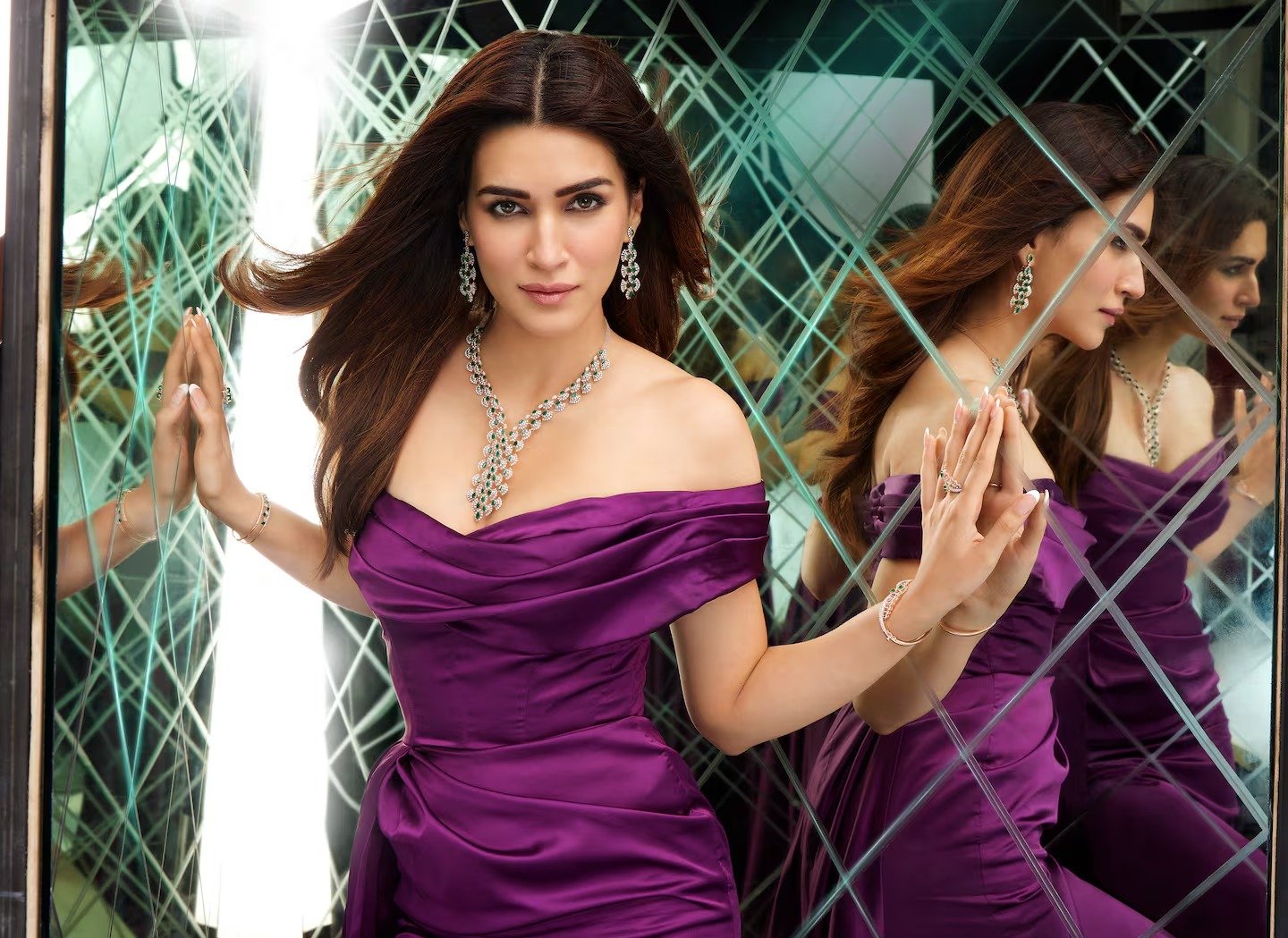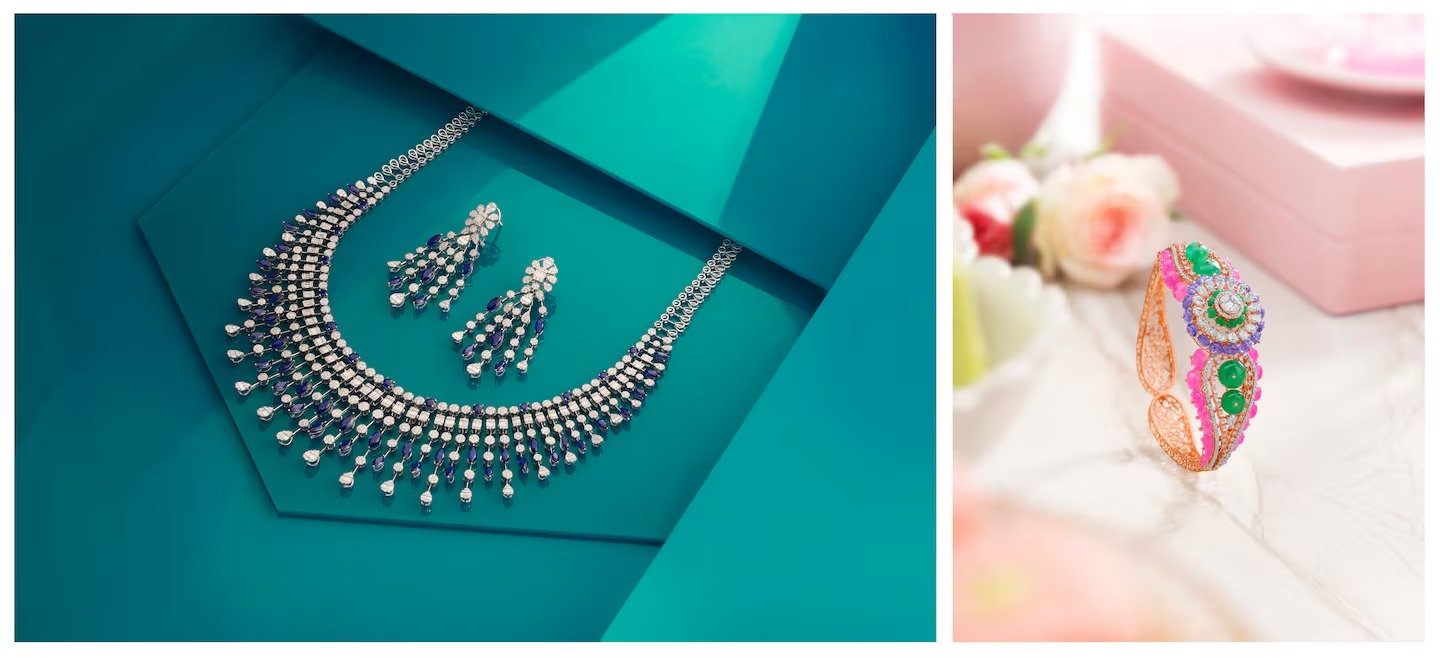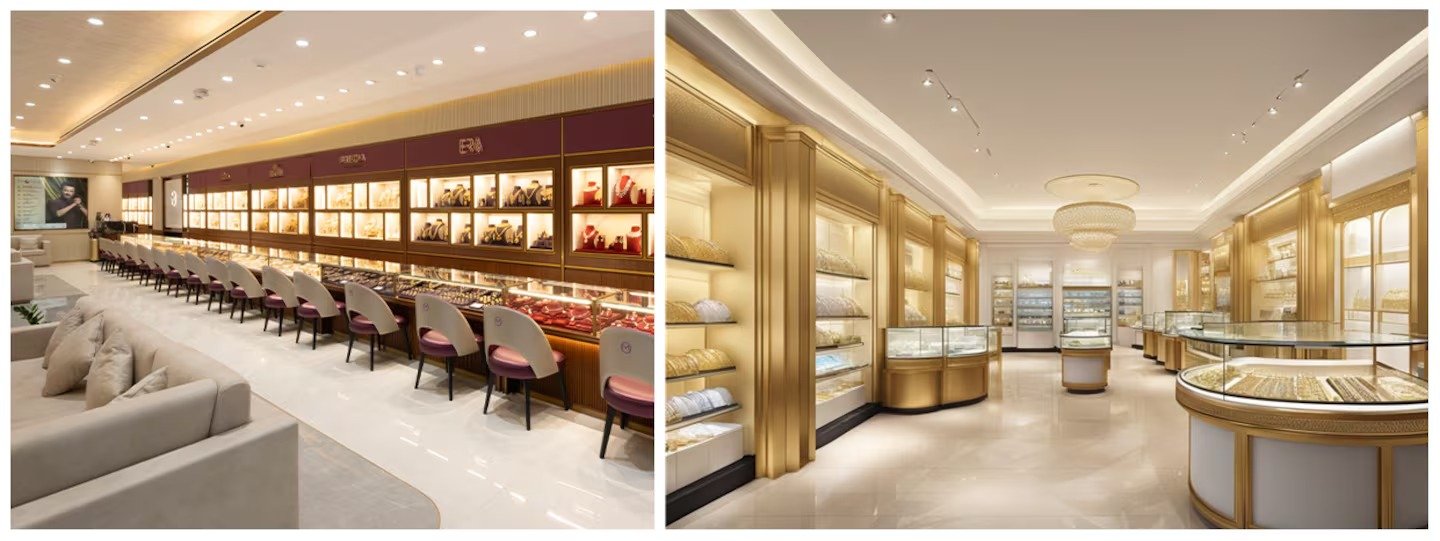
Indian Jewellers Accelerate Global Rollout From Dallas to Doha
Centuries-old heritage brands and contemporary jewellers from India are opening stores in North America, the Middle East, Southeast Asia and the UK, but few have broadened their offering to appeal to a client base beyond the South Asian diaspora.
Indian jewellers are expanding their retail footprint to serve the vast diaspora dotted around the world and outbound travellers from across the subcontinent.
Large and small Indian jewellers offer a mix of handcrafted traditional and modern pieces at mono-brand stores in the US, UAE, UK and other markets.
US tariffs may slow some brands’ expansion plans, but Indian industry bodies and company executives are hopeful about ongoing trade negotiations.
A few years ago, 125-year-old Vummidi Bangaru Jewellers (VBJ) started doing roadshows across the US, prioritising cities with high concentrations of Indian Americans. The jeweller that once made an elaborate gold sceptre for former prime minister Jawaharlal Nehru to symbolise the transfer of power from the British to India now does around 30 sleek events annually for clients in cities like Chicago, Dallas and Atlanta.
“Indians living in the US are more closely affiliated with our traditions than those at home. Even for the smallest function, they meet, wear Indian clothes and jewellery. They want to be as traditional as possible [on those occasions] because the rest of the time they miss it,” VBJ managing partner Amarendran Vummidi told BoF, adding that the roadshows typically attract hundreds of visitors at each location.
By 2023, the Chennai-based jeweller had moved beyond roadshows and opened its first international boutique in Dallas. The sprawling Texan store offers gold, silver, platinum and diamond jewellery, featuring traditional fare such as oddiyanam, ornate waist belts worn on festive occasions, in addition to other handcrafted items.
The company has plans to open more stores in the US, in locations like Virginia, Georgia and California’s Silicon Valley, but is waiting for clarity on the outcome of India’s negotiations with the US over president Donald Trump’s threat of ‘reciprocal tariffs,’ which would add a further 26 percent on top of existing levies on Indian imports.
“Tariffs are a dampener since at the end of the day the consumer is the one who’s going to pay. Since we manufacture and sell jewellery under the same retail name, there’s really no question of absorbing anything. … The cost increase would be passed on to the clients … making it unviable for [some of them] to buy,” said Vummidi.
In the meantime, VBJ and other Indian jewellers continue to capitalise on the diaspora‘s love of traditional jewellery in the US, home to about 4.8 million Indian Americans in 2022.
Tanishq, a brand owned by Tata Group’s Titan and fronted over the years by Indian film stars like Deepika Padukone and Nayanthara, has expanded its retail network to cities like Atlanta, taking the total number of overseas stores to 21. Titan’s Caratlane brand chose suburban New Jersey for its first international outlet last year.
Beyond the US, Indian jewellers have also expanded to the United Arab Emirates, Saudi Arabia, Kuwait, Singapore, Australia, Canada, South Africa, the UK and other foreign shores.
“Global expansion is enabling Indian jewellers to strategically enter diaspora-rich markets, unlocking new revenue streams and reinforcing India’s position as a leading source for high-quality gems and jewellery,” stated Kirit Bhansali, chairman of the country’s Gem & Jewellery Export Promotion Council (GJEPC).
Joyalukkas was an early mover overseas with its Abu Dhabi boutique back in 1988 and more recently opened in South Asian neighbourhoods of London like Southall and Upton Park. Chairman Joy Alukkas recently said the Kerala-founded firm, which operates 170 stores worldwide, is planning to open 12 more overseas locations this year.
It is a good time for jewellers to make capital investments, analysts suggest, because the category remains a bright spot in an otherwise decelerating luxury market.
“If you’re looking for a branded handbag, it’s a super crowded market. If you’re looking for a piece of branded jewellery, it’s a finite, very limited environment right now. So it’s fantastic that you have new [jewellery] brands coming on board because there’s a need for variety,” said Erwan Rambourg, global head of consumer and retail research at HSBC.
Prioritising the Middle East and the Anglosphere
The Indian diaspora, totalling 34.4 million people globally, is a tempting proposition for Indian jewellers. Another potential customer base consists of members of the wider South Asian diaspora. It isn’t surprising then that Malabar Gold and Diamonds is set to enter its 14th international market with a debut in New Zealand, while deepening its store network in countries like the UAE, Qatar, Saudi Arabia, Malaysia, the US, the UK, Australia and Canada.
“Our showrooms will primarily cater to the Indian subcontinent diaspora, while also appealing to local customers through curated collections that reflect each region’s local value chains and preferences,” said M.P. Ahammed, chairman of Kozhikode-based Malabar Group, using the term “showroom,” which is used in India to describe a retail space.
Unlike in the India market, where wedding jewellery reigns supreme, Malabar Gold adjusts its offering to local cultural influences and trends. In the UK and North America, it caters to higher demand for contemporary diamond and lightweight jewellery, whereas in the Gulf region of the Middle East it offers traditional designs, elaborate pieces and exclusive collections inspired by regional culture such as its “Brides of Arabia” and “Brides of Oman” ranges.
Malabar Gold, which posted about $6 billion in revenue in 2024, is now exploring expansion to European countries beyond the UK, where it already has four stores, such as France. Ahammed said the company is not averse to the idea of a retail presence in Africa and Latin America either, two regions which are under-penetrated by Indian brands.
For its part, VBJ sees enough demand in the US for 8–10 stores, after which it will look at the Gulf region, Singapore, the UK and Australia.
It’s not just the mega-brands making inroads abroad. Viren Bhagat, a sought after jeweller known for making pieces for notable clients including members of the Ambani family, opened an appointment-only salon in London’s Mayfair in January to showcase one-of-a-kind jewels.
“It gives us a base in the best connected city in the world and means we can share our creations and look after our clients more easily,” said the fourth-generation jeweller in a statement about the London outpost. Bhagat, whose family’s jewellery business was founded in 1877, creates less than 60 pieces a year at his workshops in Mumbai, using rare gemstones, such as Kashmir sapphires, Colombian emeralds and Golconda diamonds.
Jaipur-based Amrapali Jewels was an early entrant in London with a shop-in-shop at Selfridges in 2002, where it sold gold and silver jewellery. This was followed by Harrods where it sold fine jewellery next to major international brands like Cartier and Bulgari. However, the jeweller scaled down its UK business after the pandemic and the removal of VAT refunds for overseas visitors.
Amrapali now participates in private exhibitions such as the Doha Jewellery and Watches Exhibition and sells to international clients online via Net-a-Porter, Maxfield and Moda Operandi. The jeweller plans on opening a collaborative boutique with luxury home and apparel store Good Earth in Dubai this year.
Dubai is also a focus for Hazoorilal Legacy Jewellers, a 73-year-old family business started by Hazoorilal Narang with a store in Dariba in the old quarters of Delhi. This year, the jeweller opened its first international boutique at the Dubai Hills Mall after participating in jewellery exhibitions across the GCC region for over a decade. Rohan Narang, managing director of the firm and grandson of the founder, says interest from wealthy Indians and others from the subcontinent as well as Emiratis prompted them to have a permanent address in Dubai.
Most Indian jewellers operating in the Gulf are focused squarely on the South Asian diaspora. Kalyan Jewellers, which has more than 300 stores in India and the Middle East, changes its curation for different retail calendars at Dubai’s Gold Souk Mall, which it says Indians with diverse regional heritage as well as tourists from different parts of the world visit at different times of the year.
The offering at each international store is fine-tuned to the local area, says Ramesh Kalyanaraman, executive director of Kalyan Jewellers. “The inventory is curated for the population which is living in that particular micro market,” he explained, citing the brand’s stores in the UAE as an example. “The Karama Centre in Dubai is [frequented] by more South Indians, Meena Bazaar in Dubai sees more Gujarati customers. Bur Dubai sees more South Indians. Sharjah in the UAE is a predominantly Malayali market.”

Further west along the Gulf coast, Birdhichand Ghanshyamdas Jewellers opened its first international store in Doha, Qatar earlier this year. The jeweller, whose origins can be traced back to Jaipur’s Johri Bazaar in the 1930s and whose pieces have been spotted on Bollywood stars such as Kareena Kapoor Khan and Alia Bhatt, has also been doing private previews for clients in Dubai and London.
Capturing the Imagination of Non-Diaspora Clients
A few big jewellers are taking small steps to appeal to a wider clientele beyond the diaspora and clients who have a natural affinity for Indian aesthetics such as those in the Gulf.
VBJ, for example, is now collaborating with a French and an Italian company to design and manufacture a collection targeting western clients and Indians looking for more modern jewellery. Vummidi says the aim is to offer “European design at Indian prices.” He also notes that a minority of the clients coming to US roadshows are Korean, Chinese, Egyptian and Mexican.
India already has jewellers with a history of working with high-profile international clients.
Jaipur’s Gem Palace, which has been in the trade since the 1700s, has catered to the likes of Princess Diana and Jackie Kennedy. The late Munnu Kasliwal, a jewellery maker and member of the family that owns Gem Palace, was invited by the Metropolitan Museum of Art to design a special collection to sell alongside an exhibition there in 2001. His son Siddharth Kasliwal, a Gem Palace partner, runs a studio in New York and showcases at Bergdorf Goodman.
About a quarter of Siddharth Kasliwal’s clients abroad are non-resident Indians (NRIs, or India-born people living abroad), he says, while the rest are Americans, Europeans, Middle Easterners and others. Gem Palace has no plans to expand in the US but the brand is actively looking at the east Asian markets after exhibiting at the Shinsegae Department Store in Seoul.
“Koreans were only used to seeing European brands like Tiffany & Co and Cartier. [Most] hadn’t seen the colour of Indian gold jewellery, which is its purest form, [and] only seen 18 carat gold jewellery. So they were impressed by the brush or matte finish on gold which you can only achieve when crafted by hand,” said Kasliwal.
Pockets of East Asia might be an easy sell but it remains to be seen whether Indian jewellers can take market share from major western players in their home markets of Europe and North America. Some experts seem to think it’s possible but only with significant product development and adjustments to advertising, marketing and packaging.
“There’s no hurdle for an Indian company to be successful with a non-Indian target consumer if the design resonates and the price point makes sense,” said Rambourg, cautioning that it will take time for Indian companies to make inroads.

Multiple challenges await Indian companies looking to go mainstream in the west and Vummidi believes branding is the biggest one of all. “Branding is an expensive proposition. Companies need to spend millions and that’s the reason [global jewellers] charge 10 times for their products, which helps them afford rent on [prime location] streets. That is one of the disadvantages for us,” he concedes.
Anand Ramanathan, a partner at Deloitte India and lead of its consumer products and retail sector, highlights retail operations as a challenge. “[Indian jewellers’ overseas] businesses needs to be light and effective and the unit level store economics is critical for them to master,” he said.
Yet as Indian companies quietly make their mark on the world stage, some are learning, personalising and localising as they go.
They also have advantages over some international peers, namely cost, sourcing agility and manufacturing prowess. India processes 90 percent of the world’s diamonds, and is one of the largest suppliers of rough coloured stones, like emeralds and rubies. The country also boasts an ancient guild of craftspeople who are well-versed in jewellery techniques.
“When you’re making fine jewellery, the stones have to be cut and recut to match the design, and all that can be done in India since all of these factories are close by [so] it’s easy for us to create something exclusive and manufacture it while keeping the costs down. Plus we have huge skilled labour at a reasonable cost,” said Vummidi.
The Indian jewellers that have developed more contemporary ranges for young cosmopolitan locals may be better positioned to go global without having to rely too much on the “diaspora dollar.” One thing that could help them go further, experts suggest, is to develop their own recognisable motifs that become timeless signature pieces such as the Alhambra series by Van Cleef & Arpels or Cartier’s love bracelet collections.
Will Trump’s Tariff Uncertainty Play Spoilsport?
American ‘reciprocal tariffs’ would be a significant burden on Indian exporters and US consumers alike, according to the GJEPC’s Bhansali. “In the long term, we foresee a reshaping of global supply chains. In the short run, we anticipate challenges in sustaining India‘s current [gem and jewellery] export volume of $10 billion to the US market,” he said.
Rambourg says major international jewellery brands may need to increase prices by 4–5 percent to offset the impact of tariffs but the hit on consumer confidence will be more significant.
“The issue is not the impact on the prices, the issue is the impact on psychology,” he said. “Given the mood right now in the US, the risk is people will postpone purchases. People don’t [necessarily] buy jewellery or luxury because they’re wealthy but because they’re confident about the future. That confidence about the future just took a big hit in the US.”

Amrapali Jewels, which has four factories and employs about 1,600 craftspeople, says 60 percent of its export business caters to the American market. Shortly after the ‘reciprocal tariff’ announcements were made by the Trump administration, all except one US client paused their orders to the jeweller, said the creative director and CEO of the company, Tarang Arora, who nevertheless remains optimistic about the market.
Meanwhile, a trade agreement between the UK and India signed in May, which lowers British taxes on some goods imported from India, including gems and jewellery, opens new possibilities for the industry to expand there. And the European Union’s recent resumption of negotiations with India for a free trade agreement signals growth potential elsewhere.
The only question is whether India’s jewellers will adapt enough to fully grasp these overseas opportunities.
Author Credits- Arnika Thakur
Business Of Fashion









